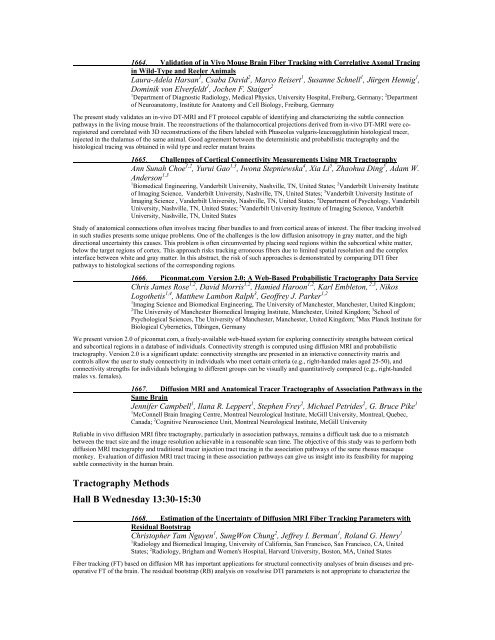Traditional Posters: Diffusion & Perfusion - ismrm
Traditional Posters: Diffusion & Perfusion - ismrm
Traditional Posters: Diffusion & Perfusion - ismrm
Create successful ePaper yourself
Turn your PDF publications into a flip-book with our unique Google optimized e-Paper software.
1664. Validation of in Vivo Mouse Brain Fiber Tracking with Correlative Axonal Tracing<br />
in Wild-Type and Reeler Animals<br />
Laura-Adela Harsan 1 , Csaba David 2 , Marco Reisert 1 , Susanne Schnell 1 , Jürgen Hennig 1 ,<br />
Dominik von Elverfeldt 1 , Jochen F. Staiger 2<br />
1 Department of Diagnostic Radiology, Medical Physics, University Hospital, Freiburg, Germany; 2 Department<br />
of Neuroanatomy, Institute for Anatomy and Cell Biology, Freiburg, Germany<br />
The present study validates an in-vivo DT-MRI and FT protocol capable of identifying and characterizing the subtle connection<br />
pathways in the living mouse brain. The reconstructions of the thalamocortical projections derived from in-vivo DT-MRI were coregistered<br />
and correlated with 3D reconstructions of the fibers labeled with Phaseolus vulgaris-leucoagglutinin histological tracer,<br />
injected in the thalamus of the same animal. Good agreement between the deterministic and probabilistic tractography and the<br />
histological tracing was obtained in wild type and reeler mutant brains<br />
1665. Challenges of Cortical Connectivity Measurements Using MR Tractography<br />
Ann Sunah Choe 1,2 , Yurui Gao 1,3 , Iwona Stepniewska 4 , Xia Li 5 , Zhaohua Ding 5 , Adam W.<br />
Anderson 1,3<br />
1 Biomedical Engineering, Vanderbilt University, Nashville, TN, United States; 2 Vanderbilt University Institute<br />
of Imaging Science, Vanderbilt University, Nashville, TN, United States; 3 Vanderbilt University Institute of<br />
Imaging Science , Vanderbilt University, Nashville, TN, United States; 4 Department of Psychology, Vanderbilt<br />
University, Nashville, TN, United States; 5 Vanderbilt University Institute of Imaging Science, Vanderbilt<br />
University, Nashville, TN, United States<br />
Study of anatomical connections often involves tracing fiber bundles to and from cortical areas of interest. The fiber tracking involved<br />
in such studies presents some unique problems. One of the challenges is the low diffusion anisotropy in gray matter, and the high<br />
directional uncertainty this causes. This problem is often circumvented by placing seed regions within the subcortical white matter,<br />
below the target regions of cortex. This approach risks tracking erroneous fibers due to limited spatial resolution and the complex<br />
interface between white and gray matter. In this abstract, the risk of such approaches is demonstrated by comparing DTI fiber<br />
pathways to histological sections of the corresponding regions.<br />
1666. Piconmat.com Version 2.0: A Web-Based Probabilistic Tractography Data Service<br />
Chris James Rose 1,2 , David Morris 1,2 , Hamied Haroon 1,2 , Karl Embleton, 2,3 , Nikos<br />
Logothetis 1,4 , Matthew Lambon Ralph 3 , Geoffrey J. Parker 1,2<br />
1 Imaging Science and Biomedical Engineering, The University of Manchester, Manchester, United Kingdom;<br />
2 The University of Manchester Biomedical Imaging Institute, Manchester, United Kingdom; 3 School of<br />
Psychological Sciences, The University of Manchester, Manchester, United Kingdom; 4 Max Planck Institute for<br />
Biological Cybernetics, Tübingen, Germany<br />
We present version 2.0 of piconmat.com, a freely-available web-based system for exploring connectivity strengths between cortical<br />
and subcortical regions in a database of individuals. Connectivity strength is computed using diffusion MRI and probabilistic<br />
tractography. Version 2.0 is a significant update: connectivity strengths are presented in an interactive connectivity matrix and<br />
controls allow the user to study connectivity in individuals who meet certain criteria (e.g., right-handed males aged 25-50), and<br />
connectivity strengths for individuals belonging to different groups can be visually and quantitatively compared (e.g., right-handed<br />
males vs. females).<br />
1667. <strong>Diffusion</strong> MRI and Anatomical Tracer Tractography of Association Pathways in the<br />
Same Brain<br />
Jennifer Campbell 1 , Ilana R. Leppert 1 , Stephen Frey 2 , Michael Petrides 2 , G. Bruce Pike 1<br />
1 McConnell Brain Imaging Centre, Montreal Neurological Institute, McGill University, Montreal, Quebec,<br />
Canada; 2 Cognitive Neuroscience Unit, Montreal Neurological Institute, McGill University<br />
Reliable in vivo diffusion MRI fibre tractography, particularly in association pathways, remains a difficult task due to a mismatch<br />
between the tract size and the image resolution achievable in a reasonable scan time. The objective of this study was to perform both<br />
diffusion MRI tractography and traditional tracer injection tract tracing in the association pathways of the same rhesus macaque<br />
monkey. Evaluation of diffusion MRI tract tracing in these association pathways can give us insight into its feasibility for mapping<br />
subtle connectivity in the human brain.<br />
Tractography Methods<br />
Hall B Wednesday 13:30-15:30<br />
1668. Estimation of the Uncertainty of <strong>Diffusion</strong> MRI Fiber Tracking Parameters with<br />
Residual Bootstrap<br />
Christopher Tam Nguyen 1 , SungWon Chung 2 , Jeffrey I. Berman 1 , Roland G. Henry 1<br />
1 Radiology and Biomedical Imaging, University of California, San Francisco, San Francisco, CA, United<br />
States; 2 Radiology, Brigham and Women's Hospital, Harvard University, Boston, MA, United States<br />
Fiber tracking (FT) based on diffusion MR has important applications for structural connectivity analyses of brain diseases and preoperative<br />
FT of the brain. The residual bootstrap (RB) analysis on voxelwise DTI parameters is not appropriate to characterize the















